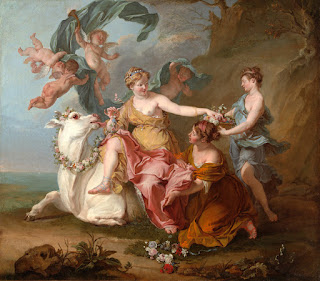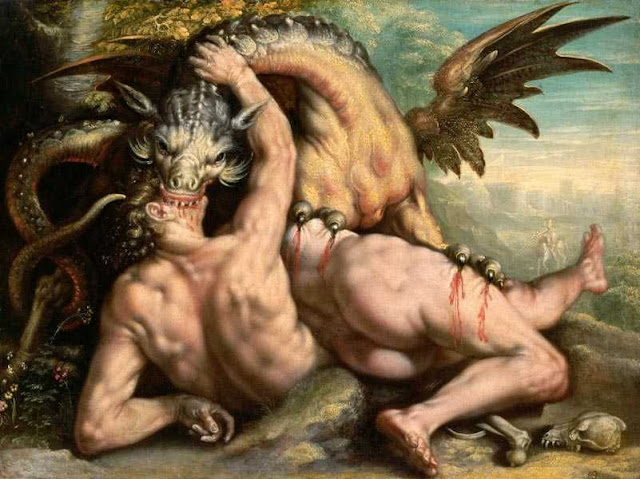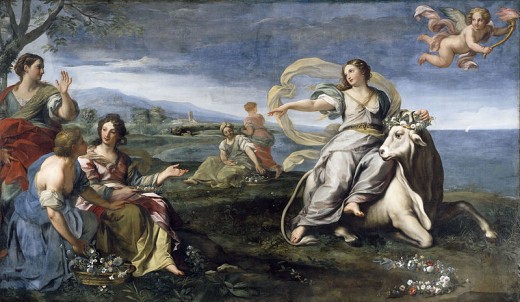AGENOR, Libya’s son by Poseidon and twin to Belus, left Egypt to settle in the Land of Canaan, where he married Telephassa, otherwise called Argiope, who bore him Cadmus, Phoenix, Cilix, Thasus and Phineus, and one daughter, Europe.
b. Zeus, falling in love with Europe, sent Hermes to drive Agenors cattle down to the seashore at Tyre, where she and her companions used to walk. He himself joined the herd, disguised as a snow-white bull with great dew-laps and small, gem-like horns, between which ran single black streak. Europe was struck by his beauty and, on finding him gentle as a lamb, mastered her fear and began to play with him putting flowers in his mouth and hanging garlands on his horns; in the end, she climbed upon his shoulders, and let him amble down with her to the edge of the sea. Suddenly he swam away, while she looked back in terror at the receding shore; one of her hands dung to his right horn, the other still held a flower-basket.
c. Wading ashore near Cretan Gortyna, Zeus became an eagle and ravished Europe in a willow-thicket beside a spring; or, some say, under an evergreen pine-tree. She bore him three sons: Minos, Rhadamanthys, and Sarpedon.
d. Agenor sent his sons in search of their sister, forbidding them to return without her. They set sail at once but, having no notion where the bull had gone, each steered a different course. Phoenix travelled westward, beyond Libya, to what is now Carthage, and there gave his name to the punics; but, after Agenor’s death, returned to Canaan, since renamed Phoenicia in his honour, and became the father of Adonis by Alphesiboea. Cilix went to the Land of the Hypachaeans, which took his name, Cilicia; and Phineus to Thynia, a peninsula separating the Sea of Marmara from the Black Sea, where he was later much distressed by harpies. Thasus and his followers, first making for Olympia, dedicated a bronze statue there to Tyrian Heracles, ten ells high, holding a club and a bow, but then set off to colonize the island of Thasos and work its rich gold mines. All this took place five generations before Heracles, son of Amphitryon, was born in Greece.
e. Cadmus sailed with Telephassa to Rhodes, where he dedicated a brazen cauldron to Athene of Lindus, and built Poseidon’s temple, leaving a hereditary priesthood behind to care for it. They next touched at Thera, and built a similar temple, finally reaching the land of the Thracian Edonians, who received them hospitably. Here Telephassa died suddenly and, after her funeral, Cadmus and his companions proceeded on foot to the Delphic Oracle. When he asked where Europe might be found, the Pythoness advised him to give up his search and, instead, follow a cow and build a city wherever she should sink down for weariness.
f. Departing by the road that leads from Delphi to Phocis, Cadmus came upon some cowherds in the service of King Pelagon, who sold him a cow marked with a white full moon on each flank. This beast he drove eastward through Boeotia, never allowing her to pause until, at last, she sank down where the city of Thebes now stands, and here he erected an image of Athene, calling it by her Phoenician name of Onga.
g. Cadmus, warning his companions that the cow must be sacrificed to Athene without delay, sent them to fetch lustral water from the Spring of Ares, now called the Castalian Spring, but did not know that it was guarded by a great serpent. This serpent killed most of Cadmus’ men, and he took vengeance by crushing its head with a rock. No sooner had he offered Athene the sacrifice, than she appeared, praising him for what he had done, and ordering him to sow the serpent’s teeth in the soil. When he obeyed her, armed Sparti, or Sown Men, at once sprang up, clashing their weapons together. Cadmus tossed a stone among them and they began to brawl, each accusing the other of having thrown it, and fought so fiercely that, at last, only five survive Echion, Udaeus, Chthonius, Hyperenor, and Pelorus, who unanimously offered Cadmus their services. But Ares demanded vengeance for the death of the serpent, and Cadmus was sentenced by a divine court to become his bondman for a Great Year.
1. There are numerous confusing variations of the genealogy given above: for instance, Thasus is alternatively described as the son of Poseidon, Cilix (Apollodorus), or Tityus (Pindar: Pythian Odes). Agenor is the Phoenician hero Chnas, who appears in Genesis as ‘Canaan’; many Canaanite customs point to an East African provenience and the Canaanites may have originally come to Lower Egypt from Uganda. The dispersal of Agenor’s sons seems to record the westward flight of Canaanite tribes early in the second millennium BC, under pressure from Aryan and Semitic invaders.
2. The story of Inachus’s sons and their search for Io the moon-cow has influenced that of Agenor’s sons and their search of Europe. Phoenix is a masculine form of Phoenissa (‘the red, or bloody one’), a title given to the moon as goddess of Death-in-Life. Europe means ‘broad- face’, a synonym for the full moon, and a title of Moon-Goddesses Demeter at Lebadeia and Astarte at Sidon. If, however, the word is not eur-ope but eu-rope (on the analogy of euboea), it may mean ‘good for willows’-that is, ‘well-watered’. The willow rules the fifth month of the sacred year, and is associated with witchcraft and with fertility rites throughout Europe, especially on May Eve, which falls in this month. Libya, Telephassa, Argiope, and Alphesiboea are all, similarly, titles of the Moon-goddess.
3. Zeus’s rape of Europe, which records an early Hellenic occupation of Crete, has been deduced from pre-Hellenic pictures of the Moon-priestess triumphantly riding on the Sun-bull, her victim; the scene survives in eight moulded plaques of blue glass, found in the Mycenaean city of Midea. This seems to have been part of the fertility ritual during which Europe’s May- garland was carried in procession (Athenaeus). Zeus’s seduction of Europe in eagle-disguise recalls his seduction of Hera in cuckoo-disguise; since (according to Hesychius) Hera bore the title ‘Europia’. Europe’s Cretan and Corinthian name was Hellotis, which suggests Helice (‘willow’); Helle, and Helen are the same divine character. Callimachus in his Epithalamion for Helen mentions that the plane-tree was also sacred to Helen. Its sanctity lay in its five- pointed leaves, representing the hand of the goddess, and its annual sloughing of bark; but Apollo borrowed it, as the God Esmun did Tanit’s (Neith’s) open-hand emblem.
4. It is possible that the story of Europe also commemorates a raid on Phoenicia by Hellenes from Crete. John Malalas will hardly have invented the ‘Evil Evening’ at Tyre when he writes: ‘Taurus (“bull”), King Crete, assaulted Tyre after a sea-battle during the absence of Agenor and his sons. They took the city that same evening and carried off many captives, Europe among them; this event is still recalled in the annual “Evil Evening” observed at Tyre’ (Chronicles). Herodotus agrees with Malalas.
5. Tyrian Heracles, whom Theseus worshipped at Olympia, was the god Melkarth; and a small tribe, speaking a Semitic language, seems to have moved up from the Syrian plains to Cadmeia in Caria-Cadmus is a Semitic word meaning ‘eastern’-whence they crossed over to Boeotia towards the end of the second millennium, seized Thebes, and became masters of the country. The myth of the Sown Men and Cadmus’s bondage to Ares suggest that the invading Cadmeans secured their hold on Boeotia by successfully intervening in a civil war among the Pelasgian tribes who claimed to be autochthonous; and that they accepted the local rule of an eight-year reign for the sacred king. Cadmus killed the serpent in the same sense as Apollo killed the Python at Delphi. The names of the Sown Men-Echion (‘viper’); Udaeus (‘of the earth’); Chthonius (‘of the soil’); Hyperenor (‘man who comes up ‘) and Pelorus (‘serpent’)-are characteristic of oracular heroes. But ‘Pelorus’ suggests that all Pelasgians, not merely the Thebans, claimed to be born in this way; their common feast being the Peloria. Jason’s crop of dragon’s teeth was probably sown at Iolcus or Corinth, not Colchis.
6. Troy and Antioch were also said to have been founded or selected by sacred cows. But it is less likely that this practice was literally carried out, than that the cow was turned loosely restricted part of a selected site and the temple of the Moon-goddess founded where she lay down. A cow’s strategic and commercial abilities are not highly developed.
b. Zeus, falling in love with Europe, sent Hermes to drive Agenors cattle down to the seashore at Tyre, where she and her companions used to walk. He himself joined the herd, disguised as a snow-white bull with great dew-laps and small, gem-like horns, between which ran single black streak. Europe was struck by his beauty and, on finding him gentle as a lamb, mastered her fear and began to play with him putting flowers in his mouth and hanging garlands on his horns; in the end, she climbed upon his shoulders, and let him amble down with her to the edge of the sea. Suddenly he swam away, while she looked back in terror at the receding shore; one of her hands dung to his right horn, the other still held a flower-basket.
d. Agenor sent his sons in search of their sister, forbidding them to return without her. They set sail at once but, having no notion where the bull had gone, each steered a different course. Phoenix travelled westward, beyond Libya, to what is now Carthage, and there gave his name to the punics; but, after Agenor’s death, returned to Canaan, since renamed Phoenicia in his honour, and became the father of Adonis by Alphesiboea. Cilix went to the Land of the Hypachaeans, which took his name, Cilicia; and Phineus to Thynia, a peninsula separating the Sea of Marmara from the Black Sea, where he was later much distressed by harpies. Thasus and his followers, first making for Olympia, dedicated a bronze statue there to Tyrian Heracles, ten ells high, holding a club and a bow, but then set off to colonize the island of Thasos and work its rich gold mines. All this took place five generations before Heracles, son of Amphitryon, was born in Greece.
e. Cadmus sailed with Telephassa to Rhodes, where he dedicated a brazen cauldron to Athene of Lindus, and built Poseidon’s temple, leaving a hereditary priesthood behind to care for it. They next touched at Thera, and built a similar temple, finally reaching the land of the Thracian Edonians, who received them hospitably. Here Telephassa died suddenly and, after her funeral, Cadmus and his companions proceeded on foot to the Delphic Oracle. When he asked where Europe might be found, the Pythoness advised him to give up his search and, instead, follow a cow and build a city wherever she should sink down for weariness.
f. Departing by the road that leads from Delphi to Phocis, Cadmus came upon some cowherds in the service of King Pelagon, who sold him a cow marked with a white full moon on each flank. This beast he drove eastward through Boeotia, never allowing her to pause until, at last, she sank down where the city of Thebes now stands, and here he erected an image of Athene, calling it by her Phoenician name of Onga.
g. Cadmus, warning his companions that the cow must be sacrificed to Athene without delay, sent them to fetch lustral water from the Spring of Ares, now called the Castalian Spring, but did not know that it was guarded by a great serpent. This serpent killed most of Cadmus’ men, and he took vengeance by crushing its head with a rock. No sooner had he offered Athene the sacrifice, than she appeared, praising him for what he had done, and ordering him to sow the serpent’s teeth in the soil. When he obeyed her, armed Sparti, or Sown Men, at once sprang up, clashing their weapons together. Cadmus tossed a stone among them and they began to brawl, each accusing the other of having thrown it, and fought so fiercely that, at last, only five survive Echion, Udaeus, Chthonius, Hyperenor, and Pelorus, who unanimously offered Cadmus their services. But Ares demanded vengeance for the death of the serpent, and Cadmus was sentenced by a divine court to become his bondman for a Great Year.
2. The story of Inachus’s sons and their search for Io the moon-cow has influenced that of Agenor’s sons and their search of Europe. Phoenix is a masculine form of Phoenissa (‘the red, or bloody one’), a title given to the moon as goddess of Death-in-Life. Europe means ‘broad- face’, a synonym for the full moon, and a title of Moon-Goddesses Demeter at Lebadeia and Astarte at Sidon. If, however, the word is not eur-ope but eu-rope (on the analogy of euboea), it may mean ‘good for willows’-that is, ‘well-watered’. The willow rules the fifth month of the sacred year, and is associated with witchcraft and with fertility rites throughout Europe, especially on May Eve, which falls in this month. Libya, Telephassa, Argiope, and Alphesiboea are all, similarly, titles of the Moon-goddess.
3. Zeus’s rape of Europe, which records an early Hellenic occupation of Crete, has been deduced from pre-Hellenic pictures of the Moon-priestess triumphantly riding on the Sun-bull, her victim; the scene survives in eight moulded plaques of blue glass, found in the Mycenaean city of Midea. This seems to have been part of the fertility ritual during which Europe’s May- garland was carried in procession (Athenaeus). Zeus’s seduction of Europe in eagle-disguise recalls his seduction of Hera in cuckoo-disguise; since (according to Hesychius) Hera bore the title ‘Europia’. Europe’s Cretan and Corinthian name was Hellotis, which suggests Helice (‘willow’); Helle, and Helen are the same divine character. Callimachus in his Epithalamion for Helen mentions that the plane-tree was also sacred to Helen. Its sanctity lay in its five- pointed leaves, representing the hand of the goddess, and its annual sloughing of bark; but Apollo borrowed it, as the God Esmun did Tanit’s (Neith’s) open-hand emblem.
5. Tyrian Heracles, whom Theseus worshipped at Olympia, was the god Melkarth; and a small tribe, speaking a Semitic language, seems to have moved up from the Syrian plains to Cadmeia in Caria-Cadmus is a Semitic word meaning ‘eastern’-whence they crossed over to Boeotia towards the end of the second millennium, seized Thebes, and became masters of the country. The myth of the Sown Men and Cadmus’s bondage to Ares suggest that the invading Cadmeans secured their hold on Boeotia by successfully intervening in a civil war among the Pelasgian tribes who claimed to be autochthonous; and that they accepted the local rule of an eight-year reign for the sacred king. Cadmus killed the serpent in the same sense as Apollo killed the Python at Delphi. The names of the Sown Men-Echion (‘viper’); Udaeus (‘of the earth’); Chthonius (‘of the soil’); Hyperenor (‘man who comes up ‘) and Pelorus (‘serpent’)-are characteristic of oracular heroes. But ‘Pelorus’ suggests that all Pelasgians, not merely the Thebans, claimed to be born in this way; their common feast being the Peloria. Jason’s crop of dragon’s teeth was probably sown at Iolcus or Corinth, not Colchis.
6. Troy and Antioch were also said to have been founded or selected by sacred cows. But it is less likely that this practice was literally carried out, than that the cow was turned loosely restricted part of a selected site and the temple of the Moon-goddess founded where she lay down. A cow’s strategic and commercial abilities are not highly developed.



Comments
Post a Comment